Mapping the Evolutions and Trends of Literature on Wayfinding in Indoor Environments
Abstract
1. Introduction
1.1. User Factors
1.1.1. Wayfinding Cognition
1.1.2. Wayfinding Behavior
1.1.3. Individual and Group Differences
1.2. Environmental Factors
2. Materials and Methods
2.1. Creating Database
2.2. Analysis Using VOSViewers
3. Results
3.1. Term Co-Occurrence Analysis (Descriptive Data)
3.2. Core Research Topics and Themes across Different Periods
3.3. Prominent Journals
3.4. Prominent Countries
3.5. Prominent Publications
3.6. Prominent Authors
4. Discussion
4.1. Theoretical Implications
4.2. Practical Implications
4.3. Limitations
4.4. Conclusions
Supplementary Materials
Author Contributions
Funding
Institutional Review Board Statement
Informed Consent Statement
Data Availability Statement
Conflicts of Interest
References
- Chen, C.H.; Chang, W.C.; Chang, W.T. Gender differences in relation to wayfinding strategies, navigational support design, and wayfinding task difficulty. J. Environ. Psychol. 2009, 29, 220–226. [Google Scholar] [CrossRef]
- Kuliga, S.F.; Nelligan, B.; Dalton, R.C.; Marchette, S.; Shelton, A.L.; Carlson, L.; Hölscher, C. Exploring Individual Differences and Building Complexity in Wayfinding: The Case of the Seattle Central Library. Environ. Behav. 2019, 51, 622–665. [Google Scholar] [CrossRef]
- Downs, R.M.; Stea, D.; Boulding, K.E. Image and Environment: Cognitive Mapping and Spatial Behavior; Aldine Publishing Company: Chicago, IL, USA, 1973. [Google Scholar]
- Arthur, P.; Passini, R. Wayfinding: People, Signs and Architecture; Mcgraw-Hill: New York, NY, USA, 1992. [Google Scholar]
- Golledge, R.G. Place Recognition and Wayfinding- Making Sense of Space. Geoforum 1992, 23, 199–214. [Google Scholar] [CrossRef]
- Cubukcu, E.; Nasar, J.L. Relation of physical form to spatial knowledge in large-scale virtual environments. Environ. Behav. 2005, 37, 397–417. [Google Scholar] [CrossRef]
- Karimi, H.A. Indoor Wayfinding and Navigation, 1st ed.; CRC Press: London, UK, 2015. [Google Scholar]
- Evans, G.W.; Marrero, D.G.; Butler, P.A. Environmental Learning and Cognitive Mapping. Environ. Behav. 1981, 13, 83–104. [Google Scholar] [CrossRef]
- Rousek, J.B.; Hallbeck, M.S. The use of simulated visual impairment to identify hospital design elements that contribute to wayfinding difficulties. Int. J. Ind. Ergon. 2011, 41, 447–458. [Google Scholar] [CrossRef]
- Eagle, A. Sprucing up wayfinding. From traditional signs to electronic kiosks, designers are making it easier to get patients to their destinations. Health Facil Manag. 2009, 22, 32–35. [Google Scholar]
- van der Ham, I.J.M.; Claessen, M.H.G. How age relates to spatial navigation performance: Functional and methodological considerations. Ageing Res. Rev. 2020, 58, 8. [Google Scholar] [CrossRef]
- Bosch, S.J.; Gharaveis, A. Flying solo: A review of the literature on wayfinding for older adults experiencing visual or cognitive decline. Appl. Ergon. 2017, 58, 327–333. [Google Scholar] [CrossRef]
- Zijlstra, E.; Hagedoorn, M.; Krijnen, W.P.; van der Schans, C.P.; Mobach, M.P. Route complexity and simulated physical ageing negatively influence wayfinding. Appl. Ergon. 2016, 56, 62–67. [Google Scholar] [CrossRef]
- Wiener, J.M.; Kmecova, H.; de Condappa, O. Route repetition and route retracing: Effects of cognitive aging. Front. Aging Neurosci. 2012, 4, 7. [Google Scholar] [CrossRef]
- Harris, M.A.; Wolbers, T. How age-related strategy switching deficits affect wayfinding in complex environments. Neurobiol. Aging 2014, 35, 1095–1102. [Google Scholar] [CrossRef]
- Head, D.; Isom, M. Age effects on wayfinding and route learning skills. Behav. Brain Res. 2010, 209, 49–58. [Google Scholar] [CrossRef]
- Chang, Y.J.; Wang, T.Y. Comparing picture and video prompting in autonomous indoor wayfinding for individuals with cognitive impairments. Pers. Ubiquitous Comput. 2010, 14, 737–747. [Google Scholar] [CrossRef]
- Lee, S.Y.; Chaudhury, H.; Hung, L.L. Exploring staff perceptions on the role of physical environment in dementia care setting. Dement. Int. J. Soc. Res. Pract. 2016, 15, 743–755. [Google Scholar] [CrossRef] [PubMed]
- Lee, S.; Kline, R. Wayfindigng Study in Virtual Environments: The Elderly vs. The Younger-Aged Groups. Archnet Ijar Int. J. Archit. Res. 2011, 5, 63–76. [Google Scholar]
- Jamshidi, S.; Ensafi, M.; Pati, D. Wayfinding in Interior Environments: An Integrative Review. Front. Psychol. 2020, 11, 24. [Google Scholar] [CrossRef]
- Siegel, A.W.; White, S.H. The Development of Spatial Representations of Large-Scale Environments. In Advances in Child Development and Behavior; Reese, H.W., Ed.; JAI: New York, NY, USA, 1975; Volume 10, pp. 9–55. [Google Scholar]
- Iachini, T.; Ruotolo, F.; Ruggiero, G. The effects of familiarity and gender on spatial representation. J. Environ. Psychol. 2009, 29, 227–234. [Google Scholar] [CrossRef]
- McNamara, T.P. Spatial memory: Properties and organization. In Handbook of Spatial Cognition; American Psychological Association: Washington, DC, USA, 2013; pp. 173–190. [Google Scholar]
- Weisberg, S.M.; Newcombe, N.S. How Do (Some) People Make a Cognitive Map? Routes, Places, and Working Memory. J. Exp. Psychol. Learn. Mem. Cogn. 2016, 42, 768–785. [Google Scholar] [CrossRef]
- Tolman, E.C. Cognitive maps in rats and men. Psychol. Rev. 1948, 55, 189–208. [Google Scholar] [CrossRef]
- Kuipers, B.; Tecuci, D.G.; Stankiewicz, B.J. The skeleton in the cognitive map—A computational and empirical exploration. Environ. Behav. 2003, 35, 81–106. [Google Scholar] [CrossRef]
- Peer, M.; Brunec, I.K.; Newcombe, N.S.; Epstein, R.A. Structuring Knowledge with Cognitive Maps and Cognitive Graphs. Trends Cogn. Sci. 2021, 25, 37–54. [Google Scholar] [CrossRef]
- Golledge, R.G.; Smith, T.R.; Pellegrino, J.W.; Doherty, S.; Marshall, S.P. A conceptual model and empirical analysis of children’s acquisition of spatial knowledge. J. Environ. Psychol. 1985, 5, 125–152. [Google Scholar] [CrossRef]
- Garling, T.; Golledge, R. Environmental Perception and Cognition. In Advance in Environment, Behavior, and Design; Zube, E.H., Moore, G.T., Eds.; Springer: Boston, MA, USA, 1989; Volume 2. [Google Scholar]
- Jones, J.W. Wayfinding: A Grounded Theory Study of the Information-Seeking Behavior of Constructors. Grounded Theor. Rev. 2016, 15, 59–75. [Google Scholar]
- Karimpur, H.; Hamburger, K. Multimodal Integration of Spatial Information: The Influence of Object-Related Factors and Self-Reported Strategies. Front. Psychol. 2016, 7, 12. [Google Scholar] [CrossRef] [PubMed]
- Verghote, A.; Al-Haddad, S.; Goodrum, P.; Van Emelen, S. The Effects of Information Format and Spatial Cognition on Individual Wayfinding Performance. Buildings 2019, 9, 29. [Google Scholar] [CrossRef]
- Van Tilburg, W.A.P.; Igou, E.R. Moving Onwards: An Action Continuation Strategy in Finding the Way. J. Behav. Decis. Mak. 2014, 27, 408–418. [Google Scholar] [CrossRef]
- Hund, A.M. Visuospatial working memory facilitates indoor wayfinding and direction giving. J. Environ. Psychol. 2016, 45, 233–238. [Google Scholar] [CrossRef]
- Choi, J.; McKillop, E.; Ward, M.; L’Hirondelle, N. Sex-specific relationships between route-learning strategies and abilities in a large-scale environment. Environ. Behav. 2006, 38, 791–801. [Google Scholar] [CrossRef]
- Schmitz, S. Gender-related strategies in environmental development: Effects of anxiety on wayfinding in and representation of a three-dimensional maze. J. Environ. Psychol. 1997, 17, 215–228. [Google Scholar] [CrossRef]
- Schmitz, S. Gender differences in acquisition of environmental knowledge related to wayfinding behavior, spatial anxiety and self-estimated environmental competencies. Sex Roles 1999, 41, 71–93. [Google Scholar] [CrossRef]
- Kober, S.E.; Neuper, C. Sex differences in human EEG theta oscillations during spatial navigation in virtual reality. Int. J. Psychophysiol. 2011, 79, 347–355. [Google Scholar] [CrossRef] [PubMed]
- Lawton, C.A. Gender Differences in Way-Finding Strategies: Relationship to Spatial Ability and Spatial Anxiety. Sex Roles 1994, 30, 765–779. [Google Scholar] [CrossRef]
- Lawton, C.A. Strategies for Indoor Wayfinding: The Role of Orientation. J. Environ. Psychol. 1996, 16, 137–145. [Google Scholar] [CrossRef]
- Dobson, S.H.; Kirasic, K.C.; Allen, G.L. Age-related Differences in Adults Spatial Task-Performance-Influences of Task Complexity and Perceptual Speed. Aging Cogn. 1995, 2, 19–38. [Google Scholar] [CrossRef]
- Davis, R.; Ohman, J. Wayfunding in aging and Alzheimer’s disease within a virtual senior residence: Study protocol. J. Adv. Nurs. 2016, 72, 1677–1688. [Google Scholar] [CrossRef]
- Davis, R.; Weisbeck, C. Creating a Supportive Environment Using Cues for Wayfinding in Dementia. J. Gerontol. Nurs. 2016, 42, 36–44. [Google Scholar] [CrossRef]
- Wilkniss, S.M.; Jones, M.G.; Korol, D.L.; Gold, P.E.; Manning, C.A. Age-related differences in an ecologically based study of route learning. Psychol. Aging 1997, 12, 372–375. [Google Scholar] [CrossRef]
- Lynch, K. The Image of the City; MIT Press: Cambridge, UK, 1960. [Google Scholar]
- O’Neill, M.J. Effects of signage and floor plan configuration on wayfinding accuracy. Environ. Behav. 1991, 23, 553–574. [Google Scholar] [CrossRef]
- Jansen-Osmann, P.; Fuchs, P. Wayfinding behavior and spatial knowledge of adults and children in a virtual environment—The role of landmarks. Exp. Psychol. 2006, 53, 171–181. [Google Scholar] [CrossRef]
- Montello, D.R.; Pick, H.L. Integrating Knowledge of Vertically Aligned Large-Scale Spaces. Environ. Behav. 1993, 25, 457–484. [Google Scholar] [CrossRef]
- Weisman, J. Evaluating Architectural Legibility-Wayfinding in the Built Environment. Environ. Behav. 1981, 13, 189–204. [Google Scholar] [CrossRef]
- Carlson, L.A.; Hölscher, C.; Shipley, T.F.; Dalton, R.C. Getting Lost in Buildings. Curr. Dir. Psychol. Sci. 2010, 19, 284–289. [Google Scholar] [CrossRef]
- Hölscher, C.; Meilinger, T.; Vrachliotis, G.; Brösamle, M.; Knauff, M. Up the down staircase: Wayfinding strategies in multi-level buildings. J. Environ. Psychol. 2006, 26, 284–299. [Google Scholar] [CrossRef]
- Baskaya, A.; Wilson, C.; Ozcan, Y.Z. Wayfinding in an unfamiliar environment-Different spatial settings of two polyclinics. Environ. Behav. 2004, 36, 839–867. [Google Scholar] [CrossRef]
- Pati, D.; Harvey, T.E.; Willis, D.A.; Pati, S. Identifying Elements of the Health Care Environment That Contribute to Wayfinding. Herd-Health Environ. Res. Des. J. 2015, 8, 44–67. [Google Scholar] [CrossRef]
- Marquardt, G. Wayfinding for People with Dementia: A Review of the Role of Architectural Design. Herd Health Environ. Res. Des. J. 2011, 4, 75–90. [Google Scholar] [CrossRef]
- Thorndyke, P.W.; Hayes-Roth, B. Differences in spatial knowledge acquired from maps and navigation. Cogn. Psychol. 1982, 14, 560–589. [Google Scholar] [CrossRef]
- Li, R.; Klippel, A. Wayfinding Behaviors in Complex Buildings: The Impact of Environmental Legibility and Familiarity. Environ. Behav. 2016, 48, 482–510. [Google Scholar] [CrossRef]
- Jamshidi, S.; Pati, D. A Narrative Review of Theories of Wayfinding Within the Interior Environment. Herd. Health Environ. Res. Des. J. 2021, 14, 290–303. [Google Scholar] [CrossRef]
- Cobo, M.J.; López-Herrera, A.G.; Herrera-Viedma, E.; Herrera, F. An approach for detecting, quantifying, and visualizing the evolution of a research field: A practical application to the Fuzzy Sets Theory field. J. Informetr. 2011, 5, 146–166. [Google Scholar] [CrossRef]
- Nalau, J.; Verrall, B. Mapping the evolution and current trends in climate change adaptation science. Clim. Risk Manag. 2021, 32, 100290. [Google Scholar] [CrossRef]
- Cobo, M.J.; López-Herrera, A.G.; Herrera-Viedma, E.; Herrera, F. Science mapping software tools: Review, analysis, and cooperative study among tools. J. Am. Soc. Inf. Sci. Technol. 2011, 62, 1382–1402. [Google Scholar] [CrossRef]
- Sharifi, A. Urban sustainability assessment: An overview and bibliometric analysis. Ecol. Indic. 2021, 121. [Google Scholar] [CrossRef]
- Van Eck, N.J.; Waltman, L. Software survey: VOSviewer, a computer program for bibliometric mapping. Scientometrics 2010, 84, 523–538. [Google Scholar] [CrossRef] [PubMed]
- Bohbot, V.D.; Iaria, G.; Petrides, M. Hippocampal function and spatial memory: Evidence from functional neuroimaging in healthy participants and performance of patients with medial temporal lobe resections. Neuropsychology 2004, 18, 418–425. [Google Scholar] [CrossRef] [PubMed]
- Wright, P.; Hull, A.J.; Lickorish, A. Navigation in a Hospital Outpatients Department- The Merits of Maps and Wall Signs. J. Archit. Plan. Res. 1993, 10, 76–89. [Google Scholar]
- Hashim, M.J.; Alkaabi, M.; Bharwani, S. Interpretation of way-finding healthcare symbols by a multicultural population: Navigation signage design for global health. Appl. Ergon. 2014, 45, 503–509. [Google Scholar] [CrossRef] [PubMed]
- Brown, B.; Wright, H.; Brown, C. A post-occupancy evaluation of wayfinding in a pediatric hospital: Research findings and implications for instruction. J. Archit. Plan. Res. 1997, 14, 35–51. [Google Scholar]
- Salthouse, T.A. When does age-related cognitive decsue begin? Neurobiol. Aging 2009, 30, 507–514. [Google Scholar] [CrossRef]
- Rodgers, M.K.; Sindone, J.A.; Moffat, S.D. Effects of age on navigation strategy. Neurobiol. Aging 2012, 33. [Google Scholar] [CrossRef]
- Bates, S.L.; Wolbers, T. How cognitive aging affects multisensory integration of navigational cues. Neurobiol. Aging 2014, 35, 2761–2769. [Google Scholar] [CrossRef]
- Moffat, S.; Zonderman, A.; Resnick, S. Age differences in spatial memory in a virtual environment navigation task. Neurobiol. Aging 2001, 22, 787–796. [Google Scholar] [CrossRef]
- Marquardt, G.; Schmieg, P. Dementia-Friendly Architecture: Environments That Facilitate Wayfinding in Nursing Homes. Am. J. Alzheimers Dis. Other Dement. 2009, 24, 333–340. [Google Scholar] [CrossRef] [PubMed]
- Passini, R.; Pigot, H.; Rainville, C.; Tetreault, M.H. Wayfinding in a nursing home for advanced dementia of the Alzheimer’s type. Environ. Behav. 2000, 32, 684–710. [Google Scholar] [CrossRef]
- Ghamari, H.; Pati, D. Examining eye-fixations during wayfinding in unfamiliar indoor environments. Int. J. Des. Objects 2018, 12, 15–33. [Google Scholar] [CrossRef]
- Livingstone-Lee, S.A.; Zeman, P.M.; Gillingham, S.T.; Skelton, R.W. Navigational strategy may be more a matter of environment and experience than gender. Learn. Motiv. 2014, 45, 30–43. [Google Scholar] [CrossRef]
- Butler, D.L.; Acquino, A.L.; Hissong, A.A.; Scott, P.A. Wayfinding by Newcomers in a Complex Building. Hum. Factors 1993, 35, 159–173. [Google Scholar] [CrossRef]
- Hund, A.M.; Nazarczuk, S.N. The effects of sense of direction and training experience on wayfinding efficiency. J. Environ. Psychol. 2009, 29, 151–159. [Google Scholar] [CrossRef]
- Padgitt, A.J.; Hund, A.M. How good are these directions? Determining direction quality and wayfinding efficiency. J. Environ. Psychol. 2012, 32, 164–172. [Google Scholar] [CrossRef]
- Castelli, L.; Corazzini, L.L.; Geminiani, G.C. Spatial navigation in large-scale virtual environments: Gender differences in survey tasks. Comput. Hum. Behav. 2008, 24, 1643–1667. [Google Scholar] [CrossRef]
- Nazareth, A.; Huang, X.; Voyer, D.; Newcombe, N. A meta-analysis of sex differences in human navigation skills. Psychon. Bull. Rev. 2019, 26, 1503–1528. [Google Scholar] [CrossRef] [PubMed]
- Balaban, C.Z.; Karimpur, H.; Roser, F.; Hamburger, K. Turn left where you felt unhappy: How affect influences landmark-based wayfinding. Cogn. Process. 2017, 18, 135–144. [Google Scholar] [CrossRef]
- Hamburger, K.; Roser, F. The Role of Landmark Modality and Familiarity in Human Wayfinding. Swiss J. Psychol. 2014, 73, 205–213. [Google Scholar] [CrossRef]
- Klippel, A.; Winter, S. Structural salience of landmarks for route directions. In Spatial Information Theory, Proceedings; Cohn, A.G., Mark, D.M., Eds.; Lecture Notes in Computer Science; Springer: Berlin, Germany, 2005; Volume 3693, pp. 347–362. [Google Scholar]
- Piccardi, L.; Bianchini, F.; Iasevoli, L.; Giannone, G.; Guariglia, C. Sex differences in a landmark environmental re-orientation task only during the learning phase. Neurosci. Lett. 2011, 503, 181–185. [Google Scholar] [CrossRef]
- Ishikawa, T.; Nakamura, U. Landmark Selection in the Environment: Relationships with Object Characteristics and Sense of Direction. Spat. Cogn. Comput. 2012, 12, 1–22. [Google Scholar] [CrossRef]
- Zhang, X.; Li, Q.Q.; Fang, Z.X.; Lu, S.W.; Shaw, S.L. An assessment method for landmark recognition time in real scenes. J. Environ. Psychol. 2014, 40, 206–217. [Google Scholar] [CrossRef]
- Viaene, P.; De Wulf, A.; De Maeyer, P. Indoor landmark-based path-finding utilizing the expanded connectivity of an endpoint partition. Environ. Plan. B Urban Anal. City Sci. 2018, 45, 233–252. [Google Scholar] [CrossRef]
- Namazi, K.; Johnson, B.D. Physical environmental cues to reduce the problems of incontinence in Alzheimer’s disease units. Am. J. Alzheimer’s Care Relat. Disord. Res. 1991, 6, 22–28. [Google Scholar] [CrossRef]
- Passini, R.; Rainville, C.; Marchand, N.; Joanette, Y. Wayfinding in dementia of the Alzheimer type: Planning abilities. J. Clin. Exp. Neuropsychol. 1995, 17, 820–832. [Google Scholar] [CrossRef] [PubMed]
- Passini, R.; Rainville, C.; Marchand, N.; Joanette, Y. Wayfinding and dementia: Some research findings and a new look at design. J. Archit. Plan. Res. 1998, 15, 133–151. [Google Scholar]
- Rainville, C.; Passini, R.; Marchand, N. A multiple case study of wayfinding in dementia of the Alzheimer type: Decision making. Aging Neuropsychol. Cogn. 2001, 8, 54–71. [Google Scholar] [CrossRef]
- Jheng, S.S.; Pai, M.C. Cognitive map in patients with mild Alzheimer’s disease: A computer-generated arena study. Behav. Brain Res. 2009, 200, 42–47. [Google Scholar] [CrossRef]
- Innes, A.; Kelly, F.; Dincarslan, O. Care home design for people with dementia: What do people with dementia and their family carers value? Aging Ment. Health 2011, 15, 548–556. [Google Scholar] [CrossRef]
- Caffo, A.O.; Hoogeveen, F.; Groenendaal, M.; Perilli, V.A.; Damen, M.; Stasolla, F.; Lancioni, G.E.; Bosco, A. Comparing two different orientation strategies for promoting indoor traveling in people with Alzheimer’s disease. Res. Dev. Disabil. 2014, 35, 572–580. [Google Scholar] [CrossRef] [PubMed]
- Mazzei, F.; Gillan, R.; Cloutier, D. Exploring the Influence of Environment on the Spatial Behavior of Older Adults in a Purpose-Built Acute Care Dementia Unit. Am. J. Alzheimer’s Dis. Other Dement. 2014, 29, 311–319. [Google Scholar] [CrossRef]
- O’Malley, M.; Innes, A.; Muir, S.; Wiener, J.M. All the corridors are the same: A qualitative study of the orientation experiences and design preferences of UK older adults living in a communal retirement development. Ageing Soc. 2018, 38, 1791–1816. [Google Scholar] [CrossRef]
- O’Malley, M.; Innes, A.; Wiener, J.M. Decreasing spatial disorientation in care-home settings: How psychology can guide the development of dementia friendly design guidelines. Dement. Int. J. Soc. Res. Pract. 2017, 16, 315–328. [Google Scholar] [CrossRef] [PubMed]
- Su, W.C.; Lu, Z.P.; Sun, Y.L.; Liu, G.F. Let eyes tell: Experimental research on university library signage system and users’ wayfinding behavior. Libr. Hi Tech 2021, 24. [Google Scholar] [CrossRef]
- Lee, H.; Lee, E.; Choi, G.S. Wayfinding Signage for People with Color Blindness. J. Inter. Des. 2020, 45, 35–54. [Google Scholar] [CrossRef]
- Rodrigues, R.; Coelho, R.; Tavares, J. Users Perceptions of Signage Systems at Three Portuguese Hospitals. Herd. Health Environ. Res. Des. J. 2020, 13, 36–53. [Google Scholar] [CrossRef]
- Shi, Y.Q.; Zhang, Y.; Wang, T.; Li, C.Y.; Yuan, S.Q. The Effects of Ambient Illumination, Color Combination, Sign Height, and Observation Angle on the Legibility of Wayfinding Signs in Metro Stations. Sustainability 2020, 12, 4133. [Google Scholar] [CrossRef]
- Andersen, N.E.; Dahmani, L.; Konishi, K.; Bohbot, V.D. Eye tracking, strategies, and sex differences in virtual navigation. Neurobiol. Learn. Mem. 2012, 97, 81–89. [Google Scholar] [CrossRef]
- Davis, R.; Sikorskii, A. Eye Tracking Analysis of Visual Cues during Wayfinding in Early Stage Alzheimer’s Disease. Dement. Geriatr. Cogn. Disord. 2020, 49, 91–97. [Google Scholar] [CrossRef] [PubMed]
- Kiefer, P.; Giannopoulos, I.; Raubal, M.; Duchowski, A. Eye tracking for spatial research: Cognition, computation, challenges. Spat. Cogn. Comput. 2017, 17, 1–19. [Google Scholar] [CrossRef]
- Schrom-Feiertag, H.; Settgast, V.; Seer, S. Evaluation of indoor guidance systems using eye tracking in an immersive virtual environment. Spat. Cogn. Comput. 2017, 17, 163–183. [Google Scholar] [CrossRef]
- De Cock, L.; Ooms, K.; Van de Weghe, N.; Vanhaeren, N.; Pauwels, P.; De Maeyer, P. Identifying what constitutes complexity perception of decision points during indoor route guidance. Int. J. Geogr. Inf. Sci. 2020, 19. [Google Scholar] [CrossRef]
- Tzeng, S.Y.; Huang, J.S. Spatial Forms and Signage in Wayfinding Decision Points for Hospital Outpatient Services. J. Asian Archit. Build. Eng. 2009, 8, 453–460. [Google Scholar] [CrossRef]
- Suzer, O.K.; Olgunturk, N. The aid of colour on visuospatial navigation of elderly people in a virtual polyclinic environment. Color Res. Appl. 2018, 43, 872–884. [Google Scholar] [CrossRef]
- Van Eck, N.; Waltman, L. VOSviewer Manual for VOSviewer Version 1.6.14; Leiden University: Leiden, The Netherlands, 2020. [Google Scholar]
- Lo, C.W.J.; Yien, H.W.; Chen, I.P. How Universal Are Universal Symbols? An Estimation of Cross-Cultural Adoption of Universal Healthcare Symbols. Herd. Health Environ. Res. Des. J. 2016, 9, 116–134. [Google Scholar] [CrossRef]
- Ishikawa, T.; Montello, D.R. Spatial knowledge acquisition from direct experience in the environment: Individual differences in the development of metric knowledge and the integration of separately learned places. Cogn. Psychol. 2006, 52, 93–129. [Google Scholar] [CrossRef] [PubMed]
- Hegarty, M.; Montello, D.R.; Richardson, A.E.; Ishikawa, T.; Lovelace, K. Spatial abilities at different scales: Individual differences in aptitude-test performance and spatial-layout learning. Intelligence 2006, 34, 151–176. [Google Scholar] [CrossRef]
- Hegarty, M.; Richardson, A.E.; Montello, D.R.; Lovelace, K.; Subbiah, I. Development of a self-report measure of environmental spatial ability. Intelligence 2002, 30, 425–447. [Google Scholar] [CrossRef]
- Bryant, K.J. Personality correlates of sense of direction and geographic orientation. J. Personal. Soc. Psychol. 1982, 43, 1318–1324. [Google Scholar] [CrossRef]
- Galea, L.A.M.; Kimura, D. Sex differences in route-learning. Personal. Individ. Differ. 1993, 14, 53–65. [Google Scholar] [CrossRef]
- Carpman, J.R.; Grant, M.A.; Simmons, D.A. Wayfinding in the Hospital Environment-the impact of Various Floor Numbering Alternatives. J. Environ. Syst. 1984, 13, 353–364. [Google Scholar] [CrossRef]
- Carpman, J.R.; Grant, M.A.; Simmons, D.A. Hospital Design and Wayfinding-a Video Simulation. Environ. Behav. 1985, 17, 296–314. [Google Scholar] [CrossRef]
- Allen, G.L. From knowledge to words to wayfinding: Issues in the production and comprehension of route directions. In Spatial Information Theory: A Theoretical Basic for Gis; Hirtle, S.C., Frank, A.U., Eds.; Lecture Notes in Computer Science; Springer: Berlin, Germany, 1997; Volume 1329, pp. 363–372. [Google Scholar]
- Darken, R.P.; Sibert, J.L. Navigating large virtual spaces. Int. J. Hum. Comput. Interact. 1996, 8, 49–71. [Google Scholar] [CrossRef]
- Devlin, A.S.; Bernstein, J. Interactive Wayfinding-Use of Cues by Men and Women. J. Environ. Psychol. 1995, 15, 23–38. [Google Scholar] [CrossRef]
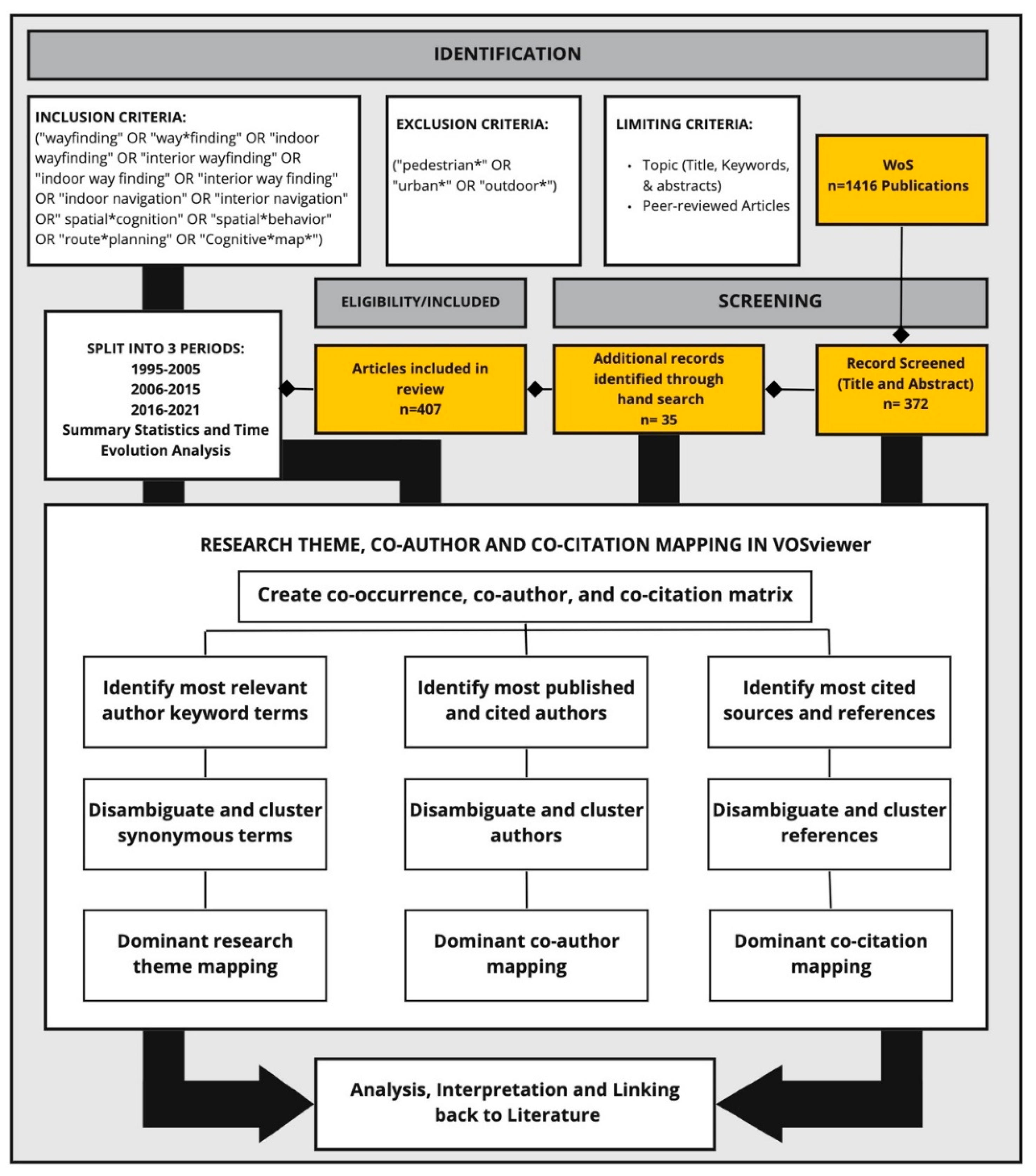
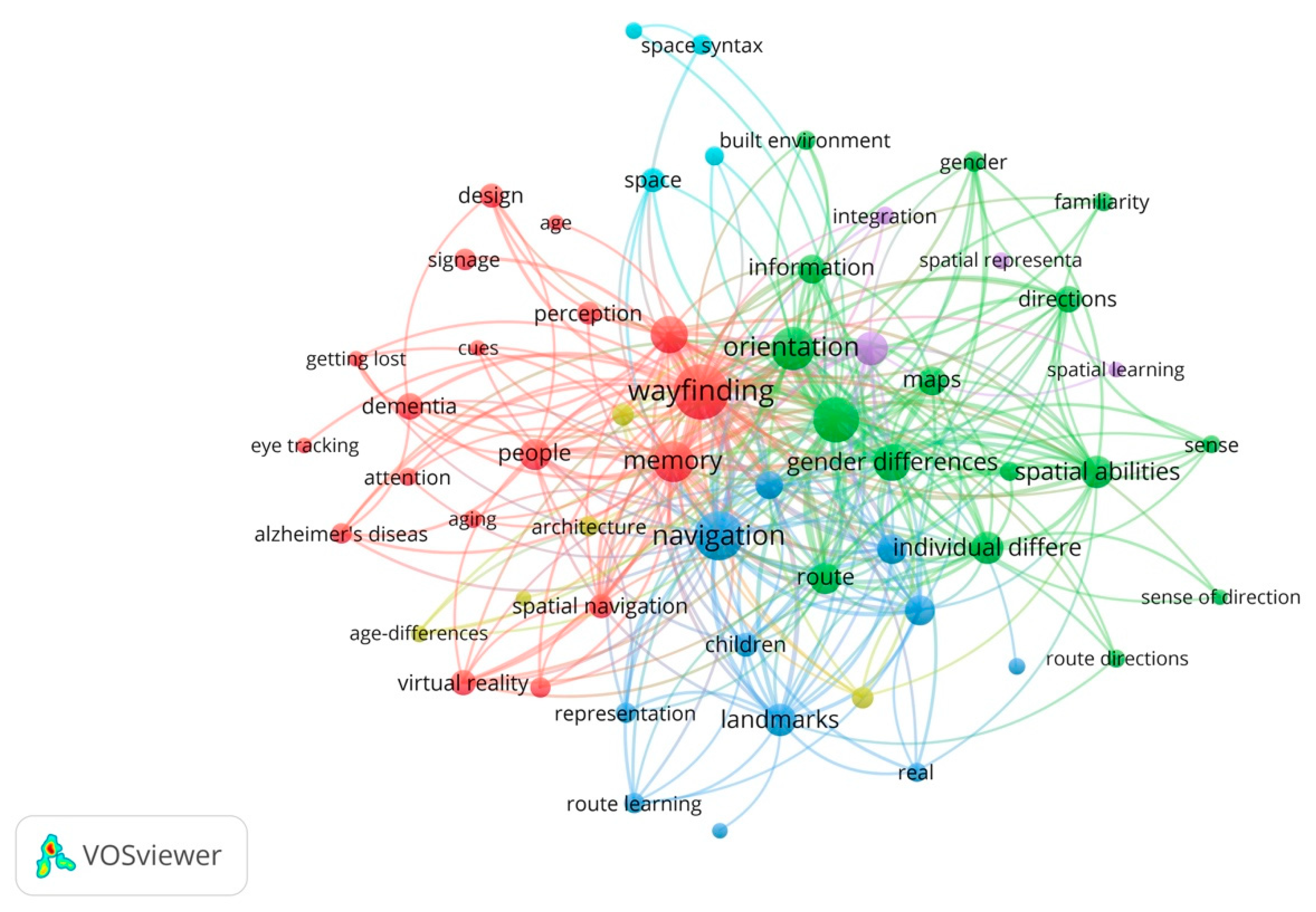
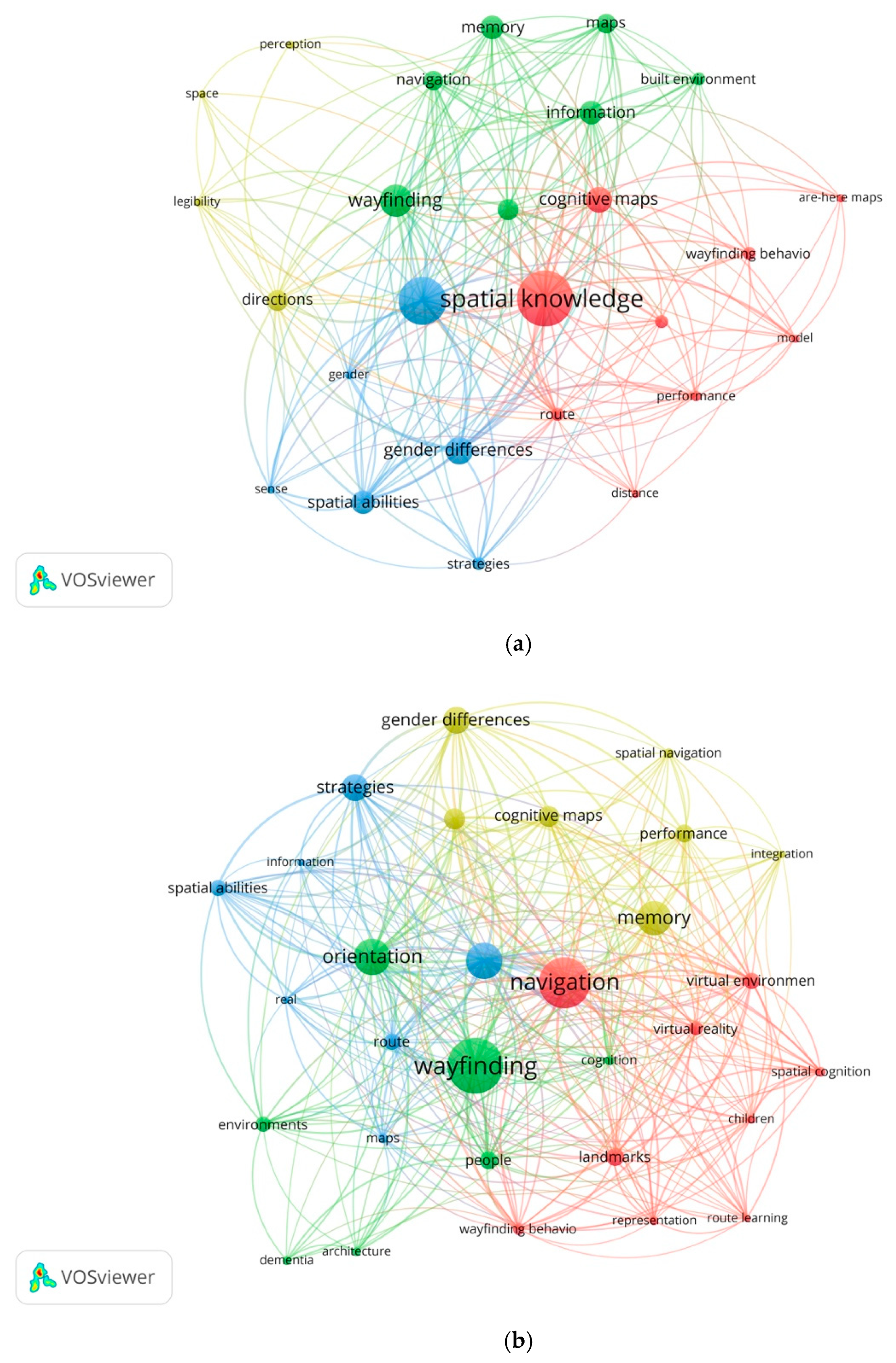
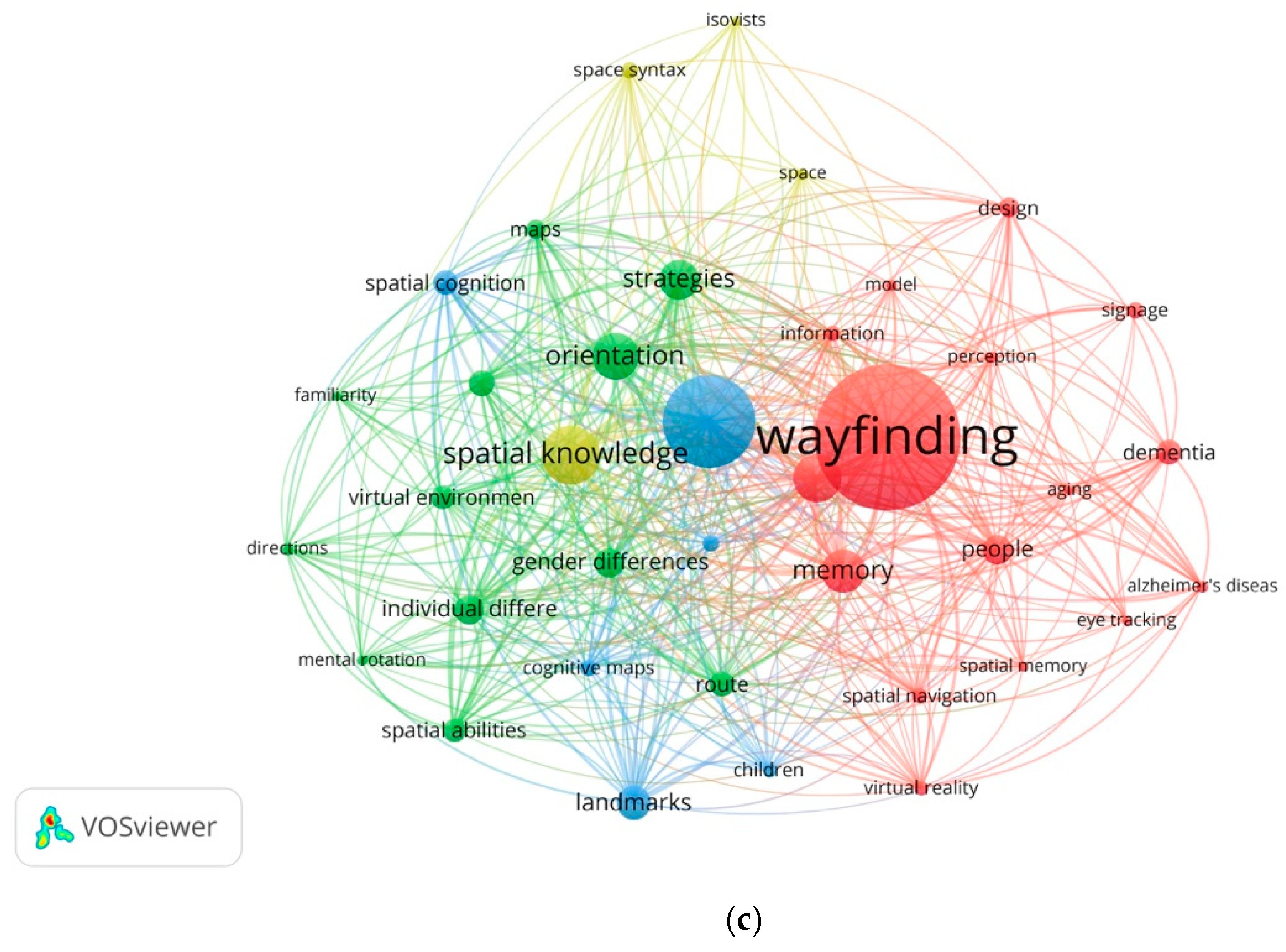

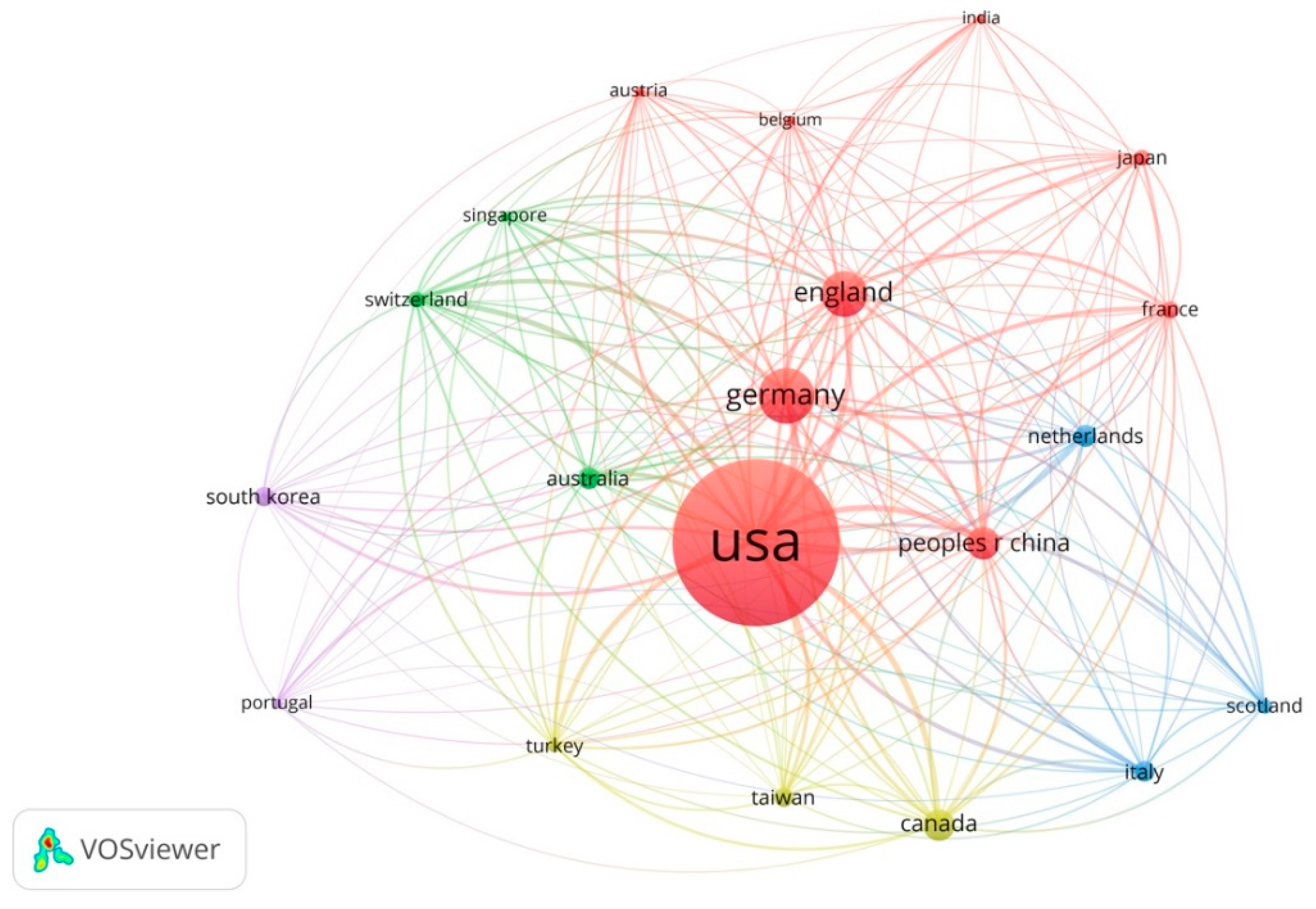

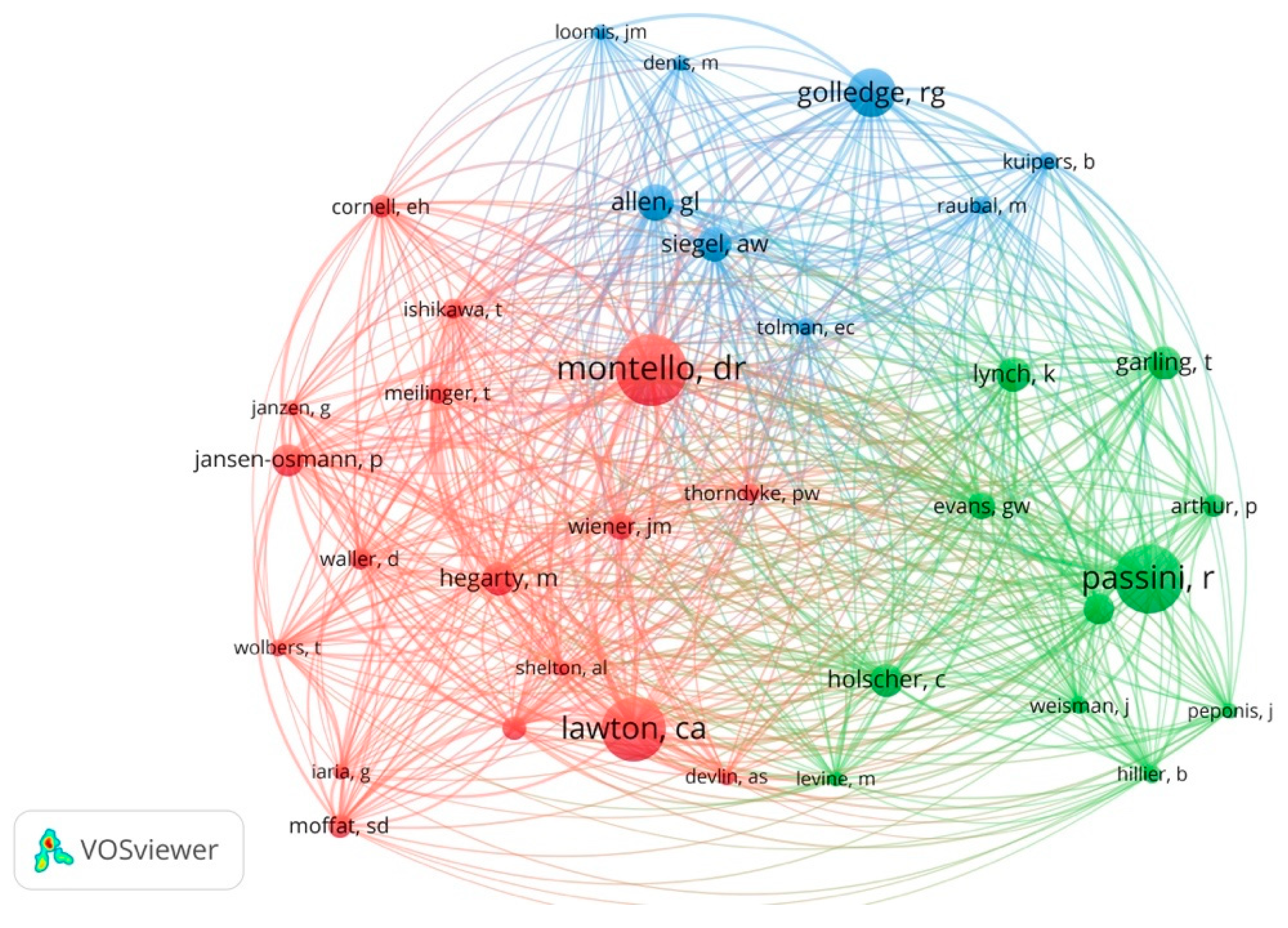
| Keyword | Occurrences | Percentage | Total Link Strength |
|---|---|---|---|
| Wayfinding | 152 | 14.5 | 1362 |
| Navigation | 108 | 10.3 | 1069 |
| Spatial Knowledge | 93 | 8.9 | 952 |
| Orientation | 81 | 7.8 | 817 |
| Memory | 66 | 6.3 | 777 |
| Environments | 53 | 5.1 | 576 |
| Gender Differences | 53 | 5.1 | 605 |
| Cognitive Maps | 40 | 3.8 | 402 |
| Individual Differences | 39 | 3.7 | 451 |
| Spatial Abilities | 39 | 3.7 | 429 |
| Landmarks | 38 | 3.6 | 424 |
| Route | 35 | 3.3 | 416 |
| People | 34 | 3.3 | 405 |
| Spatial Cognition | 30 | 2.9 | 325 |
| Virtual Environments | 30 | 2.9 | 358 |
| Maps | 29 | 2.8 | 270 |
| Information | 27 | 2.6 | 251 |
| Wayfinding Behavior | 26 | 2.5 | 286 |
| Dementia | 23 | 2.2 | 232 |
| Directions | 23 | 2.2 | 236 |
| 1981–2005 | 2006–2015 | 2016–2021 | |||||||
|---|---|---|---|---|---|---|---|---|---|
| Keywords | n | % | Keywords | n | Percentage | Keywords | n | % | |
| 1 | Spatial Knowledge | 26 | 7.7 | Wayfinding | 44 | 9.2 | Wayfinding | 93 | 11.1 |
| 2 | Orientation | 22 | 6.5 | Navigation | 40 | 8.4 | Navigation | 59 | 7.0 |
| 3 | Wayfinding | 15 | 4.4 | Orientation | 29 | 6.1 | Spatial Knowledge | 38 | 4.5 |
| 4 | Gender Differences | 13 | 3.8 | Spatial Knowledge | 29 | 6.1 | Environments | 31 | 3.7 |
| 5 | Cognitive Maps | 12 | 3.5 | Memory | 27 | 5.7 | Orientation | 30 | 3.6 |
| 6 | Information | 11 | 3.2 | Gender Differences | 21 | 4.4 | Memory | 28 | 3.3 |
| 7 | Memory | 11 | 3.2 | Cognitive Maps | 17 | 4.4 | Landmark | 22 | 2.6 |
| 8 | Spatial Abilities | 11 | 3.2 | Individual Differences | 17 | 3.6 | Gender Differences | 19 | 2.3 |
| 9 | Directions | 10 | 2.9 | Landmark | 14 | 3.6 | Individual Differences | 19 | 2.3 |
| 10 | Environments | 10 | 2.9 | People | 14 | 2.9 | People | 19 | 2.3 |
| 11 | Maps | 9 | 2.7 | Route | 13 | 2.9 | Dementia | 16 | 1.9 |
| 12 | Navigation | 9 | 2.7 | Spatial Abilities | 13 | 2.9 | Route | 16 | 1.9 |
| 13 | Built Environment | 6 | 1.8 | Virtual Environments | 13 | 2.7 | Spatial Cognition | 16 | 1.9 |
| 14 | Route | 6 | 1.8 | Environments | 12 | 2.7 | Spatial Abilities | 15 | 1.8 |
| 15 | Spatial Cognition | 6 | 1.8 | Virtual Reality | 11 | 2.7 | Virtual Environments | 15 | 1.8 |
| 16 | Wayfinding Behavior | 6 | 1.8 | Wayfinding Behavior | 9 | 2.5 | Design | 13 | 1.5 |
| 17 | You-Are-Here Maps (YAHM) | 4 | 1.2 | Cognition | 8 | 2.3 | Maps | 12 | 1.4 |
| 18 | Distance | 4 | 1.2 | Maps | 8 | 1.9 | Cognitive Maps | 11 | 1.3 |
| 19 | Gender | 4 | 1.2 | Spatial Cognition | 8 | 1.7 | Signage | 11 | 1.3 |
| 20 | Legibility | 4 | 1.2 | Spatial Navigation | 8 | 1.7 | Space Syntax | 11 | 1.3 |
| Author | Citations | Total Link Strength |
|---|---|---|
| Montello, DR | 634 | 57 |
| Höelscher, CH | 493 | 83 |
| Golledge, RG | 479 | 23 |
| Lawton, CA | 473 | 55 |
| Oneill, MJ | 299 | 55 |
| Wiener, J | 248 | 34 |
| Ishikawa, T | 189 | 16 |
| Passini, R | 170 | 17 |
| Rainville, C | 170 | 17 |
| Marchand, N | 162 | 16 |
| Raubal, M | 148 | 9 |
| Hund, A | 146 | 34 |
| Noriega, P | 144 | 49 |
| Rebelo, F | 144 | 49 |
| Vilar, E | 144 | 49 |
| Blades, M | 99 | 66 |
| Courbois, Y | 99 | 66 |
| Farran, E | 99 | 66 |
| Janzen, G | 98 | 12 |
| Jansen-Osmann, P | 73 | 29 |
| Raubal, M | 47 | 399 |
Publisher’s Note: MDPI stays neutral with regard to jurisdictional claims in published maps and institutional affiliations. |
© 2021 by the authors. Licensee MDPI, Basel, Switzerland. This article is an open access article distributed under the terms and conditions of the Creative Commons Attribution (CC BY) license (https://creativecommons.org/licenses/by/4.0/).
Share and Cite
Ghamari, H.; Sharifi, A. Mapping the Evolutions and Trends of Literature on Wayfinding in Indoor Environments. Eur. J. Investig. Health Psychol. Educ. 2021, 11, 585-606. https://doi.org/10.3390/ejihpe11020042
Ghamari H, Sharifi A. Mapping the Evolutions and Trends of Literature on Wayfinding in Indoor Environments. European Journal of Investigation in Health, Psychology and Education. 2021; 11(2):585-606. https://doi.org/10.3390/ejihpe11020042
Chicago/Turabian StyleGhamari, Hessam, and Ayyoob Sharifi. 2021. "Mapping the Evolutions and Trends of Literature on Wayfinding in Indoor Environments" European Journal of Investigation in Health, Psychology and Education 11, no. 2: 585-606. https://doi.org/10.3390/ejihpe11020042
APA StyleGhamari, H., & Sharifi, A. (2021). Mapping the Evolutions and Trends of Literature on Wayfinding in Indoor Environments. European Journal of Investigation in Health, Psychology and Education, 11(2), 585-606. https://doi.org/10.3390/ejihpe11020042







